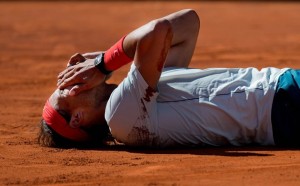 Stan Wawirnka had come into the finals playing some of the best tennis in his life. But there were signs that maybe he wasn’t ready to take on the king of clay. Wawrinka won Portugal last week, so he’s been playing almost two consecutive weeks of tennis.
Stan Wawirnka had come into the finals playing some of the best tennis in his life. But there were signs that maybe he wasn’t ready to take on the king of clay. Wawrinka won Portugal last week, so he’s been playing almost two consecutive weeks of tennis.
Once upon a time, a player like Guillermo Vilas could play week after week for nearly 3 straight months, and his body was none the worse for wear. Part of the reason was the style of play popular in the 1970s. Since hitting winners from the baseline was considered risky and even difficult (given the flat style that was popular), standard crosscourt hitting was the norm. Moving the ball around to make an opponent run was a rare strategy. Thus, you could see 10-12 cross court exchanges.
But these days, your ability to run fast and often is key to victory. One reason Nadal is so successful on clay is his ability to make his opponents run. Rafa doesn’t need to hit winners. If you’re running a lot, you’re struggling.
So two consecutive weeks of play, especially from those not at the very top, is strenuous. Most players are lucky to win 2 matches a week, and so the need to build endurance to play an additional week isn’t needed. Players like Nadal and Federer and Murray have learned to play consecutive weeks and win.
Stan had played his third consecutive three setter, and was on the brink of elimination against Tomas Berdych. He made a late match push, broke, held, and broke again, to take a match that seemed on the verge of being Berdych’s to win.
Perhaps the most damaging fact is the 17 consecutive sets he had lost to Nadal and that Nadal was playing on clay where he almost never loses.
And so that trend continued. Wawrinka started off poorly dropping to triple break point, managed to claw his way out of the hole, but delayed the inevitable break. Nadal can play Wawrinka much like he does against Federer, looping high shots to the one-handed backhand. As good as Wawrinka’s backhand is, perhaps better than Federer in terms of offensive capabilities, that tactic still works well.
Perhaps it’s a biomechanical inefficiency that prevents a one-hander from handling that shot as well as two-handers. As good as Wawrinka’s backhand is, his forehand is still capable of more offense, and in particular, capable of handling higher shots.
Nadal would go on to win 6-2, 6-4 and capture his fifth title of the year.
But more importantly, Madrid was the only clay tournament that Nadal performed poorly at last year, and so it was the only one that he could gain ground over David Ferrer. The bad news is that Ferrer also performed poorly last year, but with the win, Nadal gained ground over Ferrer.
Ferrer is now only 25 points ahead of Nadal, but Ferrer is defending semi points and Nadal is defending finalist points. Nadal could afford to lose the final if Ferrer loses very early. The two are slated to meet each other in the quarterfinals which means Ferrer is likely to lose points if he can’t beat Nadal, something that has plagued Ferrer (and pretty much everyone else). Thus, a win by Nadal in Rome and a loss by Ferrer in the quarterfinals (which would happen if Nadal wins the final) would mean Nadal comes into the finals as the fourth seed, instead of the fifth.
As a result of reaching the Madrid finals, Wawrinka reaches the top ten, showing how tenuous that tenth spot is. He pushes Janko Tipsarevic to 11th. Tipsarevic appears to be playing through injury, and has had relatively poor results to start the year.
Rome, the last Masters 1000 prior to the French Open, has started with the top seeds getting byes in the first round.



![[Paris] Djokovic finishes post US Open tournaments undefeated with win over Ferrer](https://www.essentialtennis.com/wp-content/uploads/2013/11/20131103nole-500x383.jpg)
![[Shanghai] Djokovic wins the China double, adding Shanghai title to Beijing](https://www.essentialtennis.com/wp-content/uploads/2013/10/20131013nole-500x383.jpg)
![[Shanghai, SF] del Potro upsets Nadal in awesome display of power](https://www.essentialtennis.com/wp-content/uploads/2013/10/20131012delpo-500x383.jpg)

![[Cincinnati] Nadal wins 26th Masters 1000 title with win over Isner 7-6, 7-6](https://www.essentialtennis.com/wp-content/uploads/2013/08/20130818rafa-500x383.jpg)